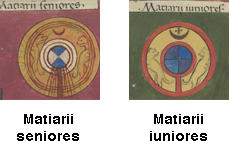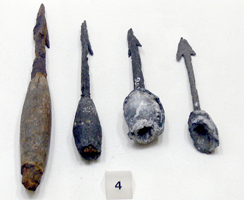
This page created 29 March 2014, and last modified: 8 October 2015 (further Maier reference numbers added)

In the eastern half of the empire, the least senior of the six legiones palatina listed (9.22 in Ingo Maier's numbering scheme) under the command of the first Master of the Soldiers in the Imperial Presence (i.e. the Magister Militum Praesentalis I) is the Matiarii iuniores. Its shield pattern (7#7) as shown in various manuscripts, under the matching label (7.g) Matiarii iuniores (but Martiarii iuniores in B, W), is as below:

The pattern features a large boss quartered purple (maroon in M, W) and blue, surrounded by a red rim with pillar underneath (white in W); the shield's rim is also red. The main ground is yellow, and features two erect yellow quadrupeds (white in W) turning their heads inwards to the shield boss; they might be hounds, but it is hard to say for sure. At the 12 o'cock position is a crescent positioned with its horns upward, surmounted by a cross in black. The shield pattern is thus similar to that of the Matiarii seniores (12.16) under the command of the second of the Masters of the Soldiers in the Imperial Presence, as these patterns taken from the Paris manuscript show:


|
The motif of an upturned crescent in the 12 o'clock position as a shield emblem is carried by not only these two units, but also the Batavi seniores (9.24), the most senior of the units of auxilia palatina under the Magister Militum Praesentalis I. The motif is, however, not restricted to these three units as shown in the Notitia. To the left is my interpretation of a fresco painted on a wall of the catacombs of San Giovanni in Syracuse, Italy. A crescent with horns turned upward can be clearly made out on the soldier's shield; it is yellow in the original, albeit badly damaged by pitting (the main ground of the shield is white). The damage to the fresco makes it unclear what smaller charge is shown (if any) between and above the horns of the crescent. That the painting appears to accurately depict a soldier with equipment contemporary (or roughly contemporary) with the Notitia can be seen by looking at the helmet, which well depicts an "Intercisa"-style example. The San Giovanni shield pattern also shows a pillar beneath the boss (which is yellow, perhaps representing a copper alloy; the shield's rim is shown in the same colour); the pillar is a dark colour, perhaps purple, and there is some sort of flowing motif in yellow to the left and right of the boss that does not correspond well to any of the patterns found in the Notitia. |

"The" Lanciarii and Mattiarii (so-spelled) are found brigaded together in Ammianus (e.g. 21.13.16; 31.13.8). When they were split into senoires and iuniores pairs is unknown, but it is interesting to note that in the Notitia it is the Lanciarii seniores (9.17) that is in the same command as the Matiarii iuniores, while the Matiarii seniores is in the same command as the Lanciarii iuniores (12.21), and that neither pairing corresponds to two adjacently-ranked units. I would suggest that this seems to imply that the two iuniores units had been relatively recently swapped between the two commands when the Notiti was first compiled.
Note that there is also another unit called the Mattiarii iuniores in the Notitia: one of the legiones comitatenses units in the western half of the empire. It is listed (98/9.106) in the Magister Peditum's infantry roster, and is assigned to his Italian command; its shield pattern is completely different from those of the eastern units (there is also a Mattiarii Honoriani Gallicani (102/5.103) assigned to the Comes Illyricum, but I believe this is a scribal mistake for Mattiaci Honoriani Gallicani).

Return to the Notitia alphabetical unit list page.
Return to my Notitia index page.